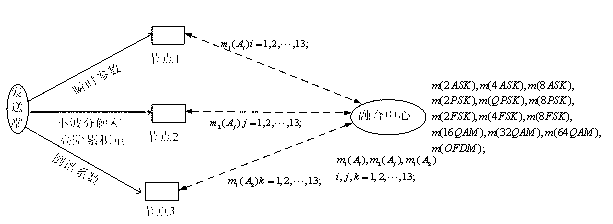Cooperative modulation identification method based on multi-class characteristic parameters and evidence theory
A technology of characteristic parameters and evidence theory, applied in the field of communication, can solve the problems of limited types, limited types of system identifiable signals, increase the types of system identifiable signals, etc., and achieve the effect of increasing types
- Summary
- Abstract
- Description
- Claims
- Application Information
AI Technical Summary
Problems solved by technology
Method used
Image
Examples
specific Embodiment approach
[0019] a. Feature extraction
[0020] The present invention adopts the following three types of characteristic parameters, which can learn from each other after being combined to improve the average recognition performance of the system. When three nodes are selected to cooperate with each other, each node extracts different types of characteristic parameters, which are characteristic parameters based on instantaneous information, characteristic parameters based on wavelet decomposition detail coefficients and high-order cumulants, and characteristic parameters based on cepstral coefficients. These characteristic parameters can characterize the target signal from different angles; when the six nodes cooperate with each other, two nodes extract the characteristic parameters based on instantaneous information, and both nodes extract the features based on wavelet decomposition detail coefficients and high-order cumulants parameters, the remaining two nodes extract feature parame...
PUM
 Login to View More
Login to View More Abstract
Description
Claims
Application Information
 Login to View More
Login to View More - R&D
- Intellectual Property
- Life Sciences
- Materials
- Tech Scout
- Unparalleled Data Quality
- Higher Quality Content
- 60% Fewer Hallucinations
Browse by: Latest US Patents, China's latest patents, Technical Efficacy Thesaurus, Application Domain, Technology Topic, Popular Technical Reports.
© 2025 PatSnap. All rights reserved.Legal|Privacy policy|Modern Slavery Act Transparency Statement|Sitemap|About US| Contact US: help@patsnap.com

